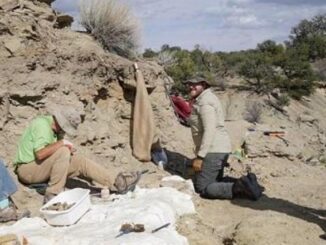
PHOENIX, Arizona, May 8, 2023 (ENS) – Bird flu has killed 21 endangered California condors in northern Arizona this spring, weakening a reintroduced flock that has been carefully nurtured for decades.
Bird flu, formally called Highly Pathogenic Avian Influenza, HPAI, has been confirmed as the cause of mortality for the condors that have died in northern Arizona, federal wildlife officials said.
To date, the bird flu virus has not been detected in the other condor populations in California or Baja California, Mexico.
The Arizona/Utah condor flock of moves throughout northern Arizona and southern Utah, using the lands within Grand Canyon National Park, Zion National Park, Vermillion Cliffs National Monument, the Kaibab Plateau, and surrounding areas.
On March 9, The Peregrine Fund, a nonprofit that manages the Arizona/Utah condor flock, first observed a bird in the wild showing signs of illness. Crews continued to monitor this bird and others showing similar behavior.
On March 20, they collected a dead female below her nest. Ten days later, she was the first condor confirmed to be HPAI positive, with the common subtype H5N1.
On April 15, the U.S. Fish and Wildlife Service established an Incident Command Team to respond to the bird flu outbreak in the Arizona-Utah flock of California condors.
At the end of 2022, the Arizona/Utah flock had 116 individuals, according to the National Park Service; 15 percent of the flock is suspected to have died from the disease.
Globally Condors Are Critically Endangered
Globally, the California Condor (Gymnogyps californianus) is listed as Critically Endangered. The species was most recently been assessed in 2020 for the IUCN Red List of Threatened Species.
Total World Population = 561
Number of wild-fledged chicks = 9
Number of birds newly released into the wild from captivity = 31
Note: the Pacific Northwest Flock was newly established as a wild flock in 2022!!
Number of mortalities in the free-flying population = 20

Protected under the Endangered Species Act and the Migratory Bird Treaty Act, the California condor is one of the largest flying birds in North America. With a wingspan of nearly 10 feet, and a body that’s four to five feet long, the condor is the size of a small car. Condors can reach speeds of 50 miles per hour when soaring, and they sometimes travel up to 200 miles a day in search of food.
One of the largest members of the vulture family, condors are scavengers that feed on dead animals – either on large mammal carrion, like deer, sheep, elk and cattle, or on smaller carrion, like rabbits, hares and coyotes. Despite their eating habits, condors bathe frequently and spend much time preening their feathers.
Total Captive Population = 214
Captive Breeding is conducted at the Peregrine Fund’s World Center for Birds of Prey, the Los Angeles Zoo, the San Diego Zoo and Safari Park and the Oregon Zoo in the United States and Chapultepec Zoo in Mexico City, Mexico.
Number of captive breeding pairs = 43
Number of captive hatched chicks = 44
Number of captive adult deaths = 0
Chicks held for release in 2023 = 39
Today condors are being reintroduced into the mountains of southern California north of the Los Angeles basin, in the Big Sur vicinity of the central California coast, near the Grand Canyon in Arizona, and in the mountains of Baja California, Mexico.
Bird Flu Could Spread Among Condors
Potential exposure of HPAI is expected to rise during the spring migration of birds north to their breeding grounds. HPAI has been detected in all U.S. states except Hawaii, in wild and domestic animals.
HPAI is considered low risk as a human health concern, according to the Centers for Disease Control and Prevention; however, infections in humans have been reported.
HPAI is highly contagious in wildlife and can spread quickly by several routes, including bird-to-bird contact, environmental contamination with fecal material, and via exposed clothing, shoes and vehicles. To protect people and birds, it is important to take precautions to prevent spread of the virus.
Precautionary Guidelines
To help limit the spread of the virus and avoid bird-human contact:
Keep your family, including pets, a safe distance away from wildlife.
Do not feed, handle or approach sick or dead animals or their droppings.
Always wash your hands after working or playing outside.
Prevent contact of domestic or captive birds with wild birds.
Leave young animals alone. Often, the parent animals are close by and will return for their young. For guidance on orphaned or injured wild birds, please contact your nearest wildlife rehabilitation center, state wildlife agency, or local land management agency.
USDA also has biosecurity guidance for people who keep backyard poultry.
In the Field, Monitoring Continues
Access to terrain for monitoring activities is improving with snowmelt. The Peregrine Fund, with support from Arizona Game and Fish Department and National Park Service, will schedule flights as needed to monitor and track radio tagged condors.
The most recent telemetry flight occurred on April 27; no new mortality signals were detected
The Peregrine Fund continues to lead daily operations of monitoring and management of the flock throughout the range and at known gathering sites, including the release site on the Vermilion Cliffs National Monument.
The Peregrine Fund continues to manage the flock to avoid congregation of birds through discontinuation of communal feeding sites and watering areas, and says their scientists are evaluating when conditions will allow for condor releases to resume.
Grand Canyon National Park and Zion National Park are monitoring portions of the flock within their respective management areas and have offered additional support as needed.
The Southwest Condor Working Group is supporting The Peregrine Fund and collaborating on monitoring condor health and behavior, identifying symptomatic birds, and transporting distressed birds to Liberty Wildlife, where they are receiving supportive care.
Ways to Help
If you see a condor exhibiting any signs of illness in Arizona or Utah, please contact The Peregrine Fund at (928) 352-8551 or condorprogram@peregrinefund.org. Signs include lethargy, incoordination, presenting as dull or unresponsive, holding head in an unusual position, and walking in circles.
If people do see condors, wildlife officials ask that observers keep their distance. Stress can be harmful to birds showing symptoms of compromised health. Limit human disturbance when encountering these birds on public lands.
Report bird mortalities to the relevant state wildlife management agency immediately so that bird die-offs can be investigated and tested for avian influenza. To report dead wild birds in Arizona call USDA 1-866-536-7593. Report dead wild birds in Utah to the local office of the Utah Division of Wildlife Resources or call the U.S. Dept of Agriculture at: 1-866-536-7593.
Featured image: California condor spreads its wings. (Photo courtesy U.S. Fish & Wildlife Service)
© 2023, Environment News Service. All rights reserved. Content may be quoted only with proper attribution and a direct link to the original article. Full reproduction is prohibited.



